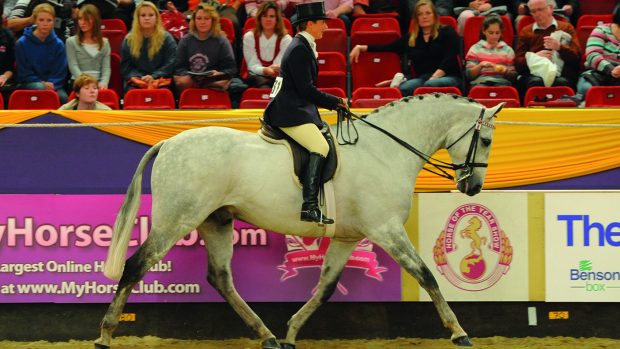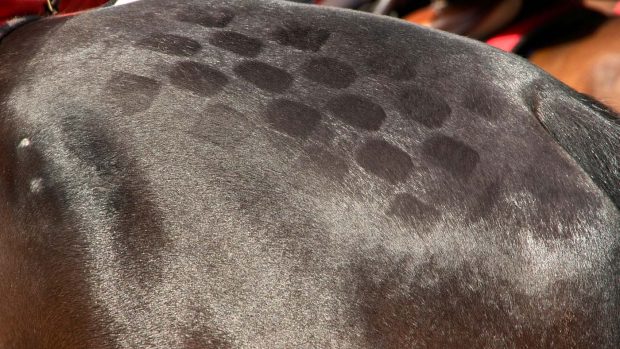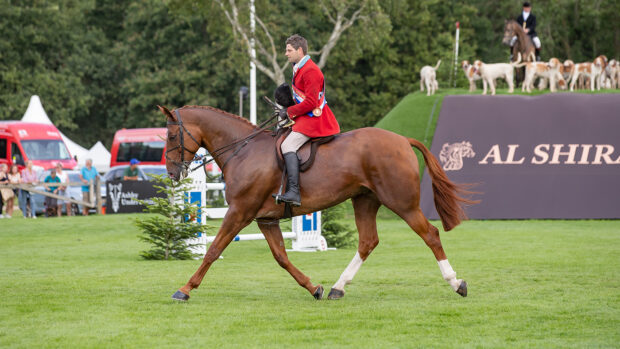A riding horse is often defined as a type that fits between a hunter and a hack, but what are some of the essentials of these classes and how can you impress the judges?
Riding horse class divisions
According to the British Show Horse Association (BSHA) the riding horse should have quality, substance, good bone, correct conformation, presence and true action.
Riding horses can be:
Small riding horse — mare or gelding, four years old or over, exceeding 148cm and not exceeding 158cm.
Large riding horse — mare or gelding, four years old or over, exceeding 158cm
The BSHA recommends that shows hold classes for both height sections if possible. If there is only one class held it must cover the full range of heights and the wording should be as follows:
Open riding horses — mare or gelding, four years old or over, exceeding 148cm
Horses may not be registered as riding horses if they have placed 1st, 2nd or 3rd in any ridden hunter class at the Royal International (RIHS) or Horse of the Year Show (HOYS) in the current or previous year.
Judging system
A riding horse class is to be judged on type, ride, manners and conformation.
The class usually entails a go-round followed by a ride judge and conformation assessment. Judges should ask class to gallop (conditions permitted). While judges must ride the exhibits first, the class may be asked to perform individual shows (from as many as time allows.)
Turnout
Riding horses should be shown with manes plaited.
Tails should be pulled and cut so that they sit just below the hock while the horse is working. You should present your horse with whiskers, jowls, heels and ears neatly trimmed.
Leading show producer Simon Reynolds says that good coat condition is imperative:
“This is achieved through a balanced diet and the right amount of rugs to keep the coat flat,” he says. “It also prevents them getting woolly and bleached from the sun. Meticulous grooming really does pay off in getting that perfect shine.”
Riding horses are shown with a coloured browband and the rider should wear a tweed jacket, unlike a navy one usually seen in hack classes.
Spurs should be worn by adults at the heel seam of the boot, not hanging off the end of the boot.
Brown, fawn or tan gloves as well as a suitable showing cane/stick are recommended.
Things to avoid
- Avoid bright hair scrunchies and ribbons and opt for a neat bun and hair net.
- Avoid “bling” on riding boots. Plain boots with a straight top rather than a shaped dressage style are also preferred.
Final preparation
Your final preparation for entering the show ring on a riding horse should include the following:
- Neatly sewn-in plaits
- Show sheen
- Hoof oil
- Chalk-white socks
- Gloss on the nose and eyes to highlight
- Quarter marks can also make for a professional and polished look, if done well
- Tack needs to be well fitted and complement the horse
- A neat sheepskin numnah that does not cover the horse up too much and does not stick out from under the saddle
Way of going
“A riding horse needs to be a good mover and have a balanced ground-covering canter,” explains Simon.
Unlike a hack class, the judge will ask a riding horse class to gallop.
Show and dressage rider and judge Jo Bates, who has won many prestigious titles on hacks and riding horses, adds: “A riding horse should really lower to the ground in the gallop, extending their stride while making it look effortless.”
Simon suggests that shoeing with light aluminium plates can keep the movement “light and low to the floor.
“We’re not looking for an off-the-floor, elevated movement with as much knee and hock action as a dressage horse, but the paces should be controlled, yet powerful,” he states.
“Manners are important, but a riding horse must also be eye-catching and memorable for a judge. Like any show horse, they must have that ‘look at me’ presence about them.”
Riding horse or hack — what’s the difference?
The first difference is the height divisions. A small hack can be no bigger than 154cm and a large cannot exceed 160cm.
“A riding horse is a ‘classier’ animal than your typical hunter, yet not as refined as a hack,” says show producer Natalie Reynolds. “Often horses may start out as a hack as a young horse but mature and strengthen to be a riding horse later on.”
A good example of this is Broadshard Simplicity, who won back-to-back supreme horse titles at Horse of the Year Show in 2014 and 2015.
“An ideal hack is as close to the Thoroughbred as possible, whereas a riding horse is a deeper girthed animal and is often crossed with the Thoroughbred to retain the quality, yet produces a more substantial type,” says Simon.
“A hack is about elegance and obedience, which comes from their origin as park horses,” says judge James Van Praagh.
“Manners are always important but with hacks it is a must. The riding horses gallop unlike the hacks, and while still obedient the ride can be more robust.”
“I like a riding horse to move with a bit more purpose than a hack – it’s not there just to look pretty,” concludes Jo.
“They must both be light and responsive, but a riding horse should have a bit more power to them.”
How to decide which type your horse is
“If you’re unsure whether your horse is a hack or a riding horse I would recommend going to a big county show to have a look at both classes,” advises Natalie. “Be sure to look at the limb, way of going and and the overall type. This will help you decide which class you think your horse fits in to. I often see many horses that are in the wrong category, or not presented in the correct way.
“I like to see a riding horse with no less than eight inches of bone below the knee. A riding horse typically has more bone than a hack. The limb is not the whole story though, and there is no specific classification for limb. It is more about the overall type. If you’re still unsure, ask a judge or professional for their opinion.”
Article continues below…
You may also be interested in:

H&H’s guide to show hunter classes: weight categories, presentation and what makes the judges cringe

A guide to show hack classes: height sections, type and how to impress the judges
H&H looks at the art of producing a show hack...

H&H’s guide to show cob classes: from weight divisions to showing off correctly
How should you present a show cob correctly and how are the different weight categories defined?

Subscribe to Horse & Hound magazine today – and enjoy unlimited website access all year round
Where to compete
All major shows will have classes for large and small riding horses, culminating in an overall riding horse championship.
At smaller shows, the small and large riding horses may be put together or may even be judged together with the hacks.
The biggest accolades a riding horse can win are the Royal International (RIHS) riding horse championship, or the riding horse of the year final held at Horse of the Year Show (HOYS) in October.
Riding horses owned and produced by amateur riders can also strut their stuff at the RIHS.
In 2019, Chainmail (Allister Hood) landed the RIHS title, while at HOYS Casino III (Jayne Ross) was top of the riding horse field.
Horse & Hound magazine, out every Thursday, is packed with all the latest news and reports, as well as interviews, specials, nostalgia, vet and training advice. Find how you can enjoy the magazine delivered to your door every week, plus options to upgrade to access our H&H Plus online service which brings you breaking news as it happens as well as other benefits.





